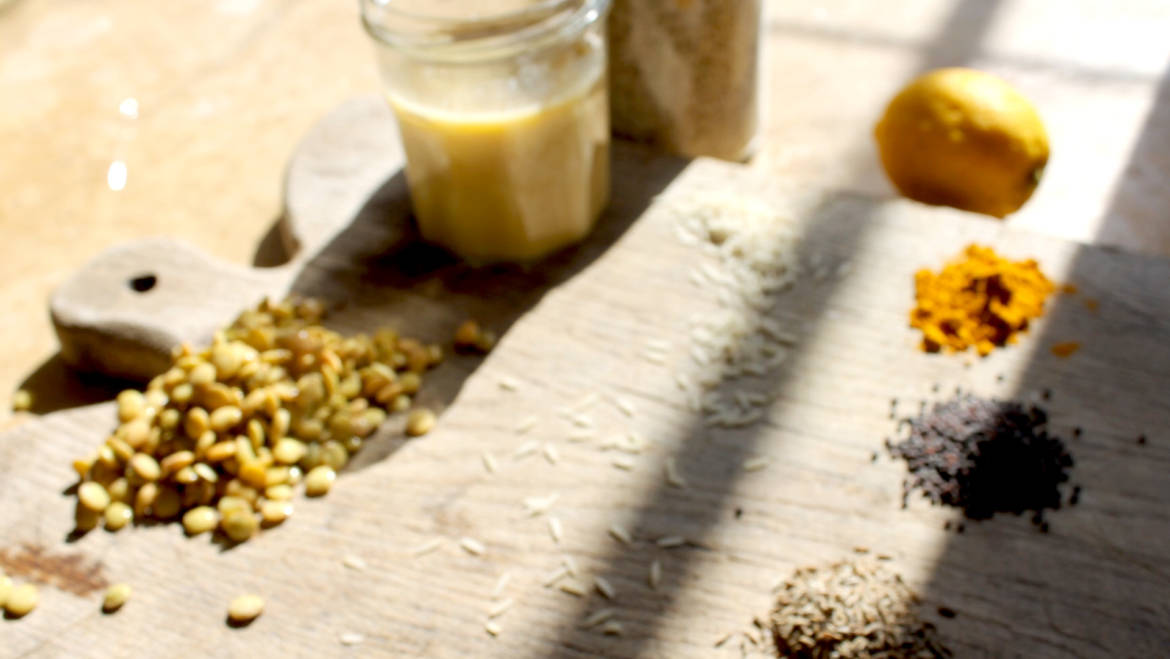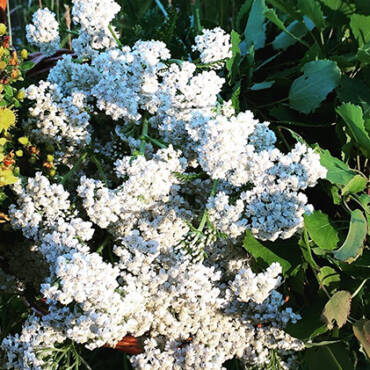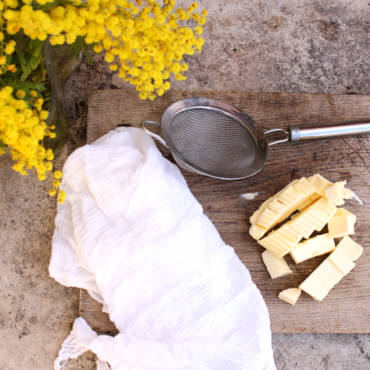SPRING CLEAN OF THE BODY
The change in season affects both our mind and body, and many feel sluggish and heavy after a long winter. Spring is about renewal and rejuvenation, and is the perfect time to cleanse the body and reboot the digestive system. There are many cleansing programs out there but we decided to try out a simple three-day detox according to ancient Ayurvedic techniques that gently cleanses the gut and resets your metabolic system. Below you’ll find more in-depth information about the cleanse regime, recipes and other tips you might need to embark on this spring clean of your body.
IT’S ALL ABOUT THE DIGESTIVE SYSTEM
In Ayurvedic philosophy, health starts in the digestive system. Cleansing is seen as a vital process to reach optimal health through clearing out accumulated waste and toxicity from both the mind and the tissues in the body. The two powerful tools for this cleansing program are kitchari and ghee. Kitchari is one of the few dishes that have a balancing effect on all three doshas; vata, pitta and kapha, while being excellent for detoxification and de-aging of the cells. Ghee is a digestive, improves absorption and assimilation of nutrition and lubricates the connective tissue. Both are very important aspects of the ayurvedic cleansing techniques.
THE DETOX PROGRAM
To maintain a mono-diet during the cleanse is key to regain the balance of your body system. When the body is fed easily digested food, it gets a well-needed rest and is able to focus more energy on self-healing and repairing itself. During the detox, you are restricted to a very simplified diet of oats and kitchari. Traditionally kitchari is eaten for all three meals, but preparing simple oats for breakfast adds some variety, is simpler to prepare in the morning and helpful if you easily tire of eating the same food. Oats are also easy to digest and calming to the stomach.
Detox cleansing teas, ghee and ginger are other components that will help the cleansing process, plus drinking plenty of water to flush out the toxins. The intake of coffee, caffeine, tobacco products, alcohol, processed food, meat, refined sugars and sweets should be reduced before and completely avoided during the detox program.
KITCHARI is a one-pot dish mainly made of rice and split yellow lentils or mung dal as they say in India. It is commonly used in cleansing programs as it’s nourishing and easy to digest, which allows energy to run through the body’s natural detoxification process. Kitchari is cleansing as well as strengthening, which makes it ideal for a detox. The mung beans are alkaline to their character and purify the blood while providing proteins to the bod
GHEE aids weight loss and lowers cholesterol, and when added to the diet, it lubricates the system and allows for a worry free digestion process. Ghee is best bought organic or prepared at home using organic grass fed butter. See our previous blog post for more information and recipe.




KEY POINTS OF THE DETOX PROGRAM:
- Cooked oatmeal for breakfast (or kitchari if you want to do it 100% kitchari diet)
- Kitchari for lunch and dinner
- Lunch should be the main meal of the day
- Avoid snacking as much as possible
- There is no need to starve yourself – eat until you are satisfied but make sure not to over eat
- Leave at least 3 hours between each meal
- Do not eat after 7pm
- Drinks plenty of water and detox tea in order to flush out the toxins
- Make sure all ingredients during the detox program are organic and of good quality
- Always remember to soak the yellow split lentils the night before in clean water
- Minimise stress around you and in your life during the regime
- Avoid too many activities during the three days – gentle exercise, yoga asanas and walking is good in order to aid the cleansing
- Try to eat fresh food as much as possible – to prepare a big batch of kitchari for all meals of the day is absolutely fine but eating leftovers the day after is not recommended in order to get the maximum nutrition from the food
- The ayurvedic herb mix Triphala is advised to be taken each day during the cleanse – we skipped this for this time
- We finished each day with golden milk with ghee
WHAT TO EXPECT
We found this a highly manageable and effective cleansing program. During the three days, we experienced some ups and downs both on a physical and emotional level, which is normal during the detoxification process. However, it was still easy to manage all the daily tasks as normal, and we really noticed and enjoyed the results of the detox.
Here are some notes from our journey through the detox:
DAY 1
The first day was all about getting used to the regime and the food. No bigger issues or problems. Had to remind myself not to grab a fruit or piece of chocolate when feeling a little hungry. Took a spoonful of kitchari instead.
DAY 2
The mono-diet and no-snacking part became challenging especially day 2 when emotions were running a little high due to the new activities in the body.
DAY 3
Felt much better than day 2 and completing daily tasks with much more energy.
DAY 4
Really feeling fantastic. The body and mind feels light and clean. Slowly easing back into a normal diet. After the mono-fast, all flavours, even the tiniest hint of sweet, felt like an explosion for the taste buds.
RECIPES
Breakfast oats
- ½ cup | 1 dl organic oats
- 1 ½ cup | 3 dl water
- cinnamon, cardamom, nutmeg or ginger powder to taste
- Cook the oats in water on low heat and add ¼ tsp of the additional spices


Kitchari – serves 1-2 people for one day
- 1 cup | 2 dl white basmati rice
- 1 cup | 2 dl yellow split mung beans/lentils
- 2 tbs ghee
- ¼ tsp black mustard seeds
- ½ tsp cumin seeds
- 1 tsp fresh grated ginger
- ½ tsp turmeric powder
- ½ tsp coriander powder
- ½ fennel seeds /powder
- 1 pinch of hing (asafoetida) – optional if tricky to find
- 1 tsp salt – Himalayan or natural mineral salt
- 4 cardamom pods
- 6 cups | 3 dl water
- 2 cups easily digestible root vegetables (carrots, turnips, celery, sweet potato, zucchini and green beans)
- pinch of black pepper
- squeeze of lemon
- cilantro, coriander or parsley to garnish
- Soak the mung beans overnight or at least 4 hours before preparation of meal
- Strain the mung beans, combine with the rice in a strainer and rinse thoroughly with water
- Warm the ghee in a pot on medium heat and add the mustard and cumin seeds – sauté in the ghee for a few minutes until the mustard seeds start to pop
- Add the rest of the spices – ginger, turmeric, coriander and fennel plus the pinch of hing* while stirring
- Pour in the rice/mung bean mix and stir into the spices and let sauté for a few moments
- Add the water and turn up the heat to bring it to a boil
- Stir in the salt plus cardamom pods and turn down the heat and let simmer under a lid for about 40 minutes
- Half way through – after about 15/20 min, add the chopped up vegetables of your choice
- Continue to cook until the rice, the lentils and the vegetables are completely cooked. The consistency of the kitchari should be that of a stew or a risotto dish
- Finally add the black pepper, a squeeze of lemon and add some fresh green herbs as a garnish
*HING or asafoetida powder is used a lot in Indian cooking and gives the dish a slight garlicky/oniony taste. It also prevents gas from building up in the stomach when on a vegetarian diet and consuming a lot of lentils, cauliflower, chickpeas etc. that can cause gas building in the digestion system


Detox Tea
- 1 tsp cumin seeds
- 1 tsp coriander seeds
- 1 tsp fennel seeds
- ½ litre water
- Bring the water and seeds to a boil
- Let simmer for 5 minutes then turn off the heat and let stand for another 5 minutes
- Strain and serve the tea
Golden Milk with Ghee – serves 1 person
- 1 cup | 2 dl almond milk (home made preferably)
- 1 tsp ghee
- ½ tsp organic turmeric powder
- pinch of black pepper
- pinch of ginger, cinnamon, nutmeg or cardamom is optional
- Mix the turmeric powder and black pepper at the bottom of the pan in a small amount of water until a smooth paste forms
- Add the milk and ghee and mix until it’s a smooth liquid forms
- Let simmer on low-medium heat for circa 5 minutes
- Add the additional spices and serve






2 Comments
Cool post, do you mind if I link to it from my new blog/tea shop?
Its called Lovely Tea Teas? Thanks in advance – Oliver aka
Mr Tea
Hello Oliver,
No I dont mind at all. Please could you let me know your blog site?
-Maxine
Add Comment